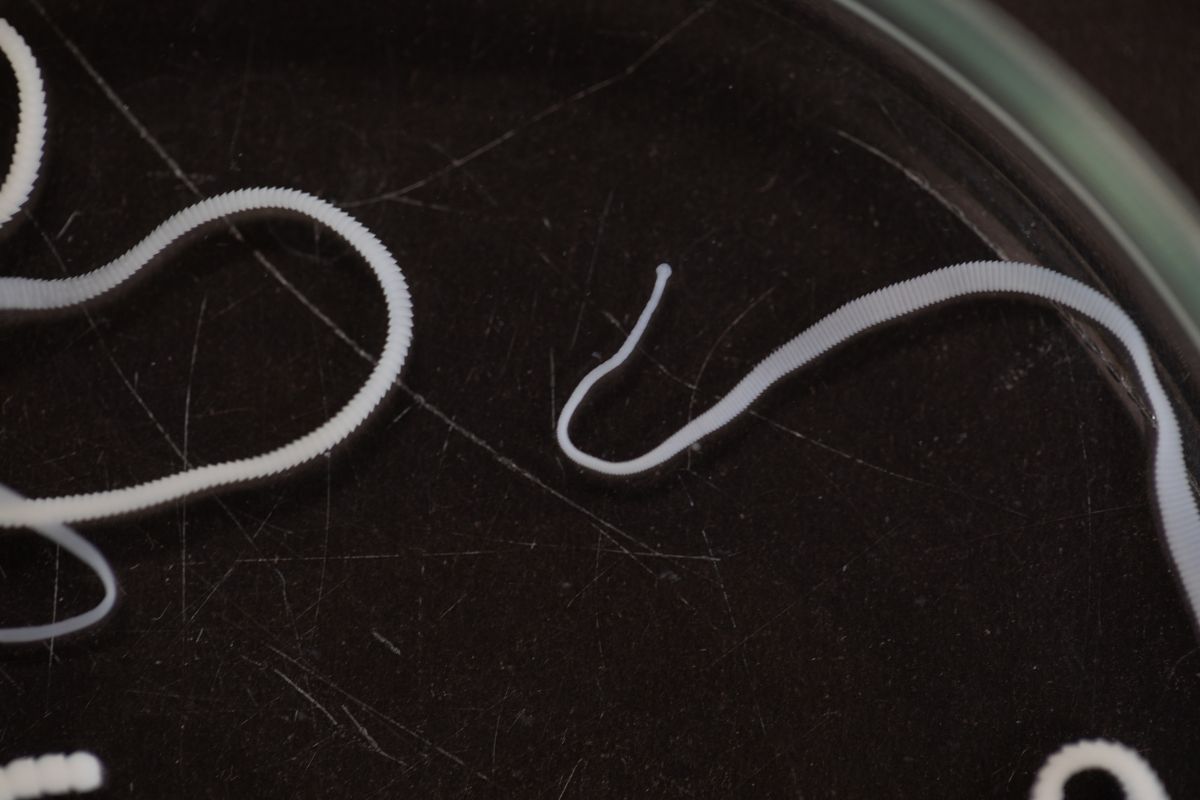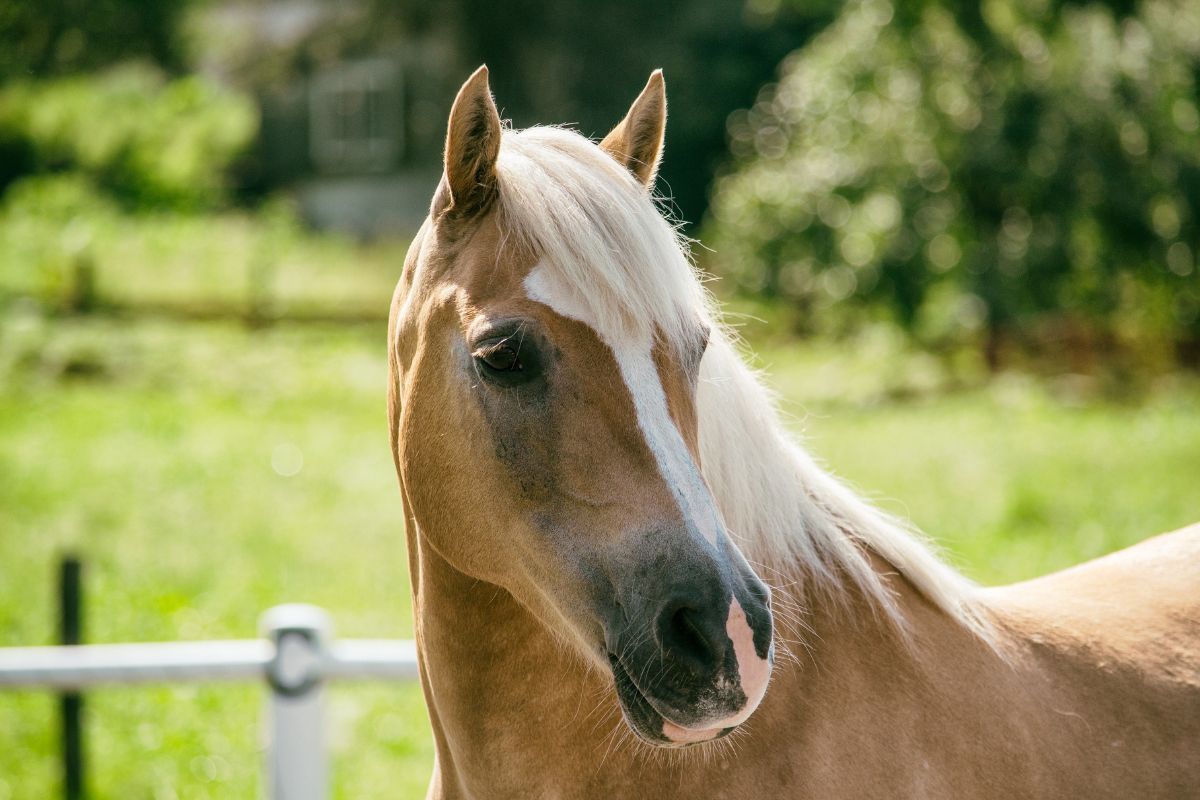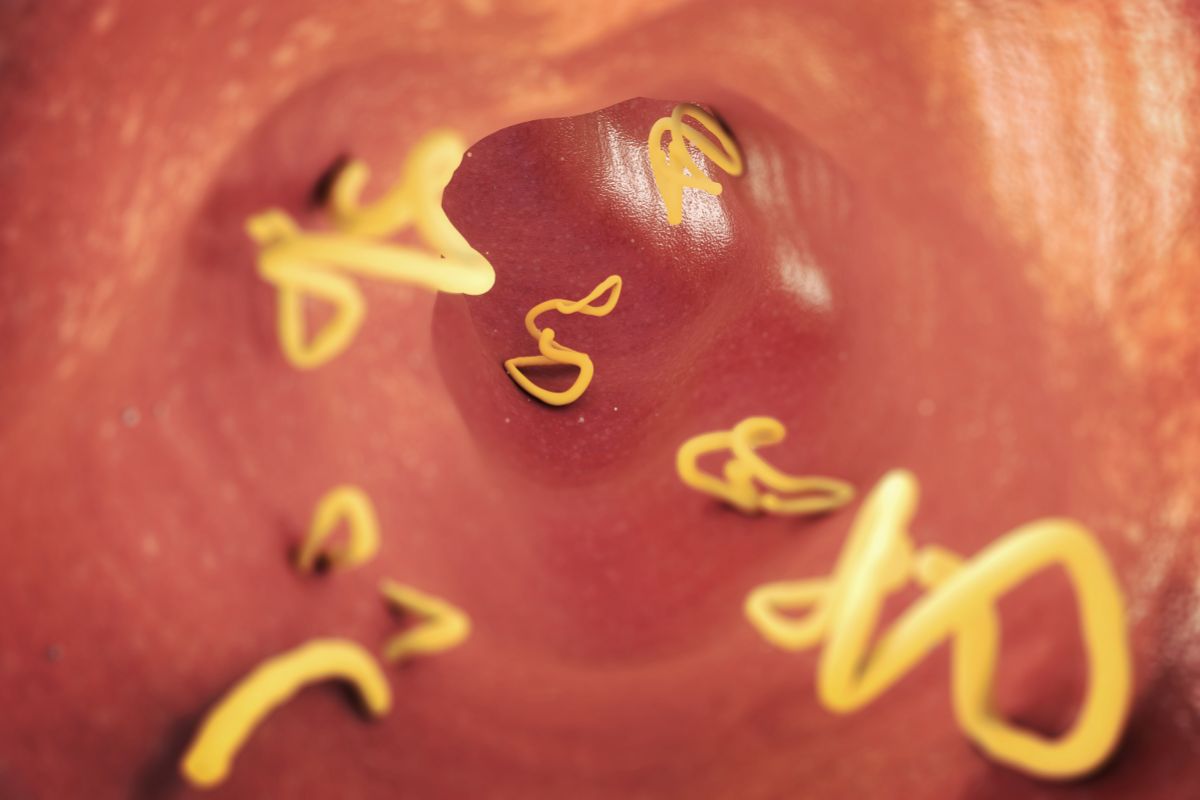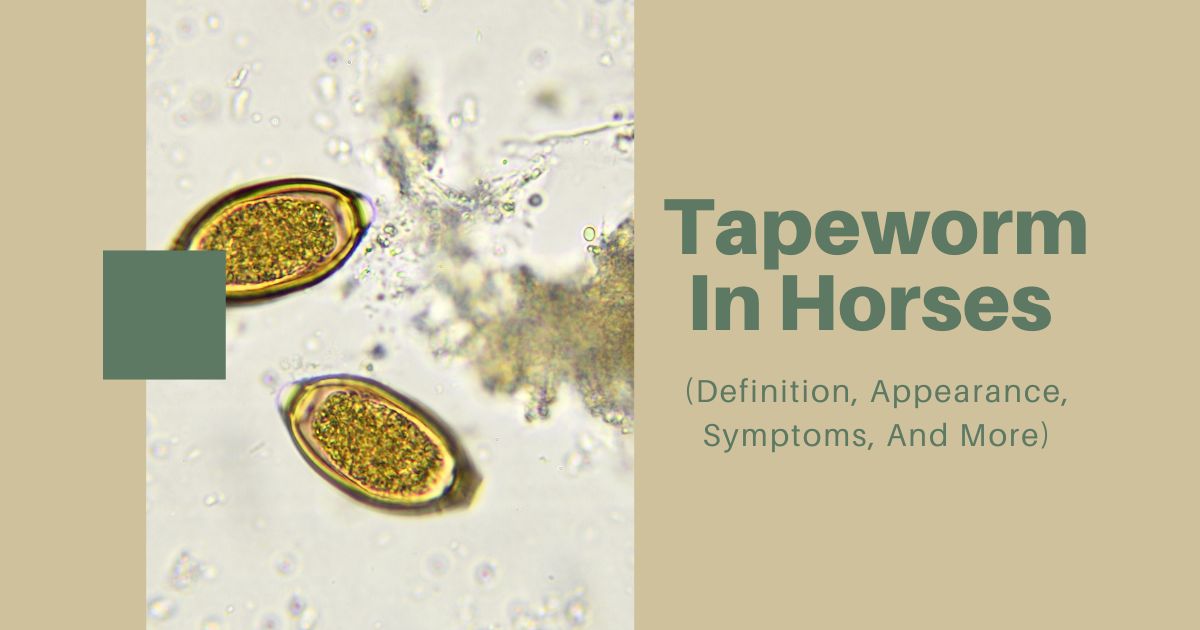What are Horse Tapeworms?
Tapeworms are a type of internal parasite that attaches to a horse’s intestinal lining to use as a source of nutrition. Most vets in the past considered tapeworm in horses to be an incidental finding on postmortems, but new research shows that these worms are not as harmless as once thought.
Tapeworms in horses are difficult to diagnose because they do not exhibit clearly defined symptoms, and eggs often go undetected during routine fecal exams.

What Do Tapeworm Larvae Look Like?
Unlike conventional tapeworms in dogs, sheep, or cattle, horse tapeworm specimens are small pumpkin-seed-shaped parasites and not long-chain segments. The worms are yellow or green, and their size is around one inch (2,5 cm) long and a half an inch (0,25cm) wide.
Symptoms of Equine Tapeworms
Most symptoms of worms in horses cause apparent changes in a horse’s weight, coat condition, or habitus. Tapeworms differ because they create subtle clinical changes often not picked up by owners or vets immediately.
These elusive worms increase risk factors for spasmodic colics and distal small intestine impactions depending on the affected region of the gut.
When many worms attach to the ileal or cecal walls, it may result in tapeworm-associated colic. The colic may result from mechanical obstruction due to large worm build-ups, gut mucosa inflammation, and damage or pain from multiple confluent necrotic ulcers at worm attachment sites.
Necrotic ulcers are the suspected cause of increased intestinal peristalsis, leading to spasmodic colic, ileal impactions, and ileocecal intussusceptions.
In horses with suspected impactions of the ileum or ileocecal intussusceptions, the following symptoms may occur:
- Coat conditions may diminish due to nutritional deficiencies.
- Performance abilities may regress due to lethargy, malaise, and abdominal discomfort.
- Increased incidences of bloating and flatulence may occur.
- Depressed appetites and weight loss.
- Dry and impacted feces.
- Pawing at the ground, flank-checking and nipping, and trying to lie down and roll.
More serious colic symptoms that a vet may look for include the following:
- Increased heart rate with increased respiration.
- Sweating.
- Decreased gut sounds due to a lack of peristalsis.
- Dehydration.
- Congested mucous membranes.
- Rectal palpation may reveal a firm intestinal mass.
- A positive gastric reflux may occur.
- Moderate to severe pain
The initial symptoms of tapeworms are relatively nonspecific. The issue does not lie with the damage the tapeworms create to the mucosal gut lining but rather the decrease in gut motility that may lead to colic.
Parasites create a more severe problem for young horses as the nutritional deficiency caused by parasitism leads to anemia and poor growth and development.
How is a Diagnosis Made?
Diagnosing a tapeworm infection in a horse is difficult due to the small number of eggs in stool samples. Another compounding factor is that the eggs are not released individually but in tapeworm egg sacs that do not float in a regular egg flotation medium.
Recently dewormed horses may sometimes shed dead tapeworms in their stool, but it is rare to see with the naked eye.
Routine fecal exams such as the Mcmaster technique often fail to detect tapeworm eggs, and over ninety percent of infected horses go undiagnosed. A modified fecal egg count technique is available but is more advanced, and only some clinics offer this service. This technique requires the centrifugation of feces to concentrate and float the eggs.
ELISA tests measure anti-tapeworm antibodies in serum or saliva, which confirm recent parasite exposure but not a definitive current infection.

Available Treatment Options
The two anthelmintics that kill tapeworms in horses are praziquantel and pyrantel pamoate.
Praziquantel works by increasing the cell membrane permeability to calcium ions which induce muscle spasms in the tapeworm. The contractions result in paralysis and death. After the worms die, they dislodge from the attachment site, and the immune system removes them.
Over-the-counter treatments combine macrocyclic lactones such as ivermectin or moxidectin with praziquantel for a more broad-spectrum deworming action.
Pyrantel pamoate is a depolarizing neuromuscular blocking agent that creates sudden contractions and paralysis in worms. The worms dislodge from the intestinal wall and get excreted through the gastrointestinal tract.
There is a risk that a horse with a significant worm burden may suffer from intestinal obstruction if a substantial number of worms die and enter the gut lumen. Continually monitor horses closely after administering any dewormer medications.
It is advisable to use a double dose of pyrantel to treat worm burdens successfully. A single dose only clears between eighty to 85 percent of the worms, whereas a double dose reduces the worm burden by up to 95 percent.
Anthelmintic resistance in tapeworms is not prevalent currently. Still, emerging resistance may not be easy to detect due to the asymptomatic nature of the worms and the difficulty in diagnosing infections.
Commonly available brands of tape wormer for horses include:
- Quest Plus.
- ComboCare.
- Zimecterin Gold.
- Equimax Paste.
How To Administer a Horse Dewormer
It is always essential to consult your vet and stable manager when deciding what dewormer to use and when to use it. Using the correct dosage and ensuring that the horses receive the total amount is significant to ensure the effective deworming of your horse and to avoid anthelmintic drug resistance.
Listed below are a few critical steps to consider when deworming your horse:
- Correct dose – Ensure that you have an accurate estimate of your horse’s weight to administer the correct quantity of dewormer. A weight tape is an easy way to estimate your horse’s weight. Most vets will advise dosing slightly above the weight of your horses as they are very safe drugs.
- Order backup medication – Horses can be challenging to dose oral medication to, so have a little extra available if your horse pulls a fast one and you fail to administer the total amount. Underdosing leads to ineffective treatment.
- Clean out your horse’s mouth – Remove any possible food from the horse’s mouth to ensure that the medication administration is unobstructed by food. Secure the horse’s halter gently in one hand and slowly retract the lips to check for food on both sides of the mouth.
Encourage the horse to open its mouth slowly by inserting a finger between the gap of its incisors and molars – where the bit goes. On the other side, with the free hand, gently grasp the tongue and guide it to the side to check for any more food. - Once the mouth is clear of food, secure the horse’s halter with one hand and gently insert the syringe tip between the gap described above. Depress the syringe slowly and administer the paste directly onto the tongue in intervals to allow the horse to swallow.
If your horse resists this, you may need to mix the dewormer into some food.
Deworming a horse should never feel like a dance with death. Some horses present a severe challenge, but an owner should consult a vet to administer the medication instead of taking unnecessary risks.
The Different Types of Tapeworms in Horses
Three main tapeworm species infect equines:
- Anoplocephala perfoliata.
- Anoplocephaloides mamillana.
- Anoplocephala magna.
The species with the most clinical significance is Anoplocephala perfoliata which occurs worldwide in grazing horses except in arid regions.
A. perfoliata has a triangular body and is short with a yellow-to-green coloration. The worm’s size varies between one to three inches (three to eight centimeters). The worm’s head has four suckers that attach to the lining of the horse’s gut and absorbs nutrients through its cuticle. This attachment damages the mucosal lining.
The remaining two species, Anoplocephaloides mamillana and Anoplocephala magna are rare in well-managed horses, and studies have not yet shown any association with disease in horses.
Anoplocephala magna measures up to thirty-one inches long (80 cm) and about one inch (2.5 cm) wide. Anoplocephaloides mamillana measures up to two inches long and is only about 0,1 inches (5 mm) wide.
Causes and Transmission
The cause of tapeworm in horses is the ingestion of free-living common oribatid mites that carry the infective stage of the parasite. The forage mites ingest tapeworm eggs passed through an infected horse’s stool onto the pasture. These mites act as intermediate hosts when grazing horses consume them from infected fields.
Tapeworms have an indirect life cycle, meaning an intermediate host is required for the parasite to develop. The oribatid mite is the intermediate host when ingesting the tapeworm’s eggs. The immature tapeworm grows into a larva in the mite’s body cavity over twelve to fifteen weeks.
Once a grazing horse ingests the mite, the worm enters the gastrointestinal tract. The tapeworm develops over six to ten weeks into an adult and then attaches to the mucosal lining of the small intestine around the ileocecal valve.
The adult worms shed segments known as proglottids as they mature and fill with eggs. The segments released into the intestinal contents disintegrate and release eggs into the intestinal lumen. The eggs are passed through the GI tract, exit through the horse’s stool, and infect the pastures, where the life cycle starts again.
In pastures where horses graze seasonally, the tapeworm burden is low in summer and high over the winter and early spring months.
Horse tapeworms cannot infect humans or other animals, and horses cannot contract tapeworms from dogs, cats, livestock, or wildlife.
The other types of tapeworms have similar life cycles to A. perfoliata, with one main difference being that they occupy the small intestine and not the cecum.
To ensure the prevention of tapeworm transmission, owners and stable managers need to consider pasture management strategies that will reduce worm exposure and ingestion. Refrain from overstocking paddocks, and regularly remove dung piles to reduce the number of eggs entering the grazing environment.
The Prognosis
Once a horse undergoes anthelmintic treatment, they usually make a full recovery. Any symptoms from colic secondary to tapeworm infection should resolve after treatment. The prognosis may change if the colic progresses without treatment, so discussing a horse’s recovery with the attending vet is essential.
A veterinarian should devise a routine annual deworming schedule for treatments once or twice a year to prevent helminth-associated colics from recurring.

Summary
Tapeworm in horses and their role in colic has opened a big can of worms for vets and owners alike. The correct anthelmintic treatments should be given regularly as a part of routine primary health care protocols. Pasture management to rotate grazing areas and clean out dung reduces exposure to tapeworm infection.
The effect of tapeworms goes unnoticed in many horses, but for those owners who monitor their equine companions closely, recurrent mild colics will start to raise a red flag.
Tapeworms are a small and avoidable colic risk. By ensuring that horses remain free of internal parasites, owners provide them with the best opportunity to develop fully and achieve their true potential.
